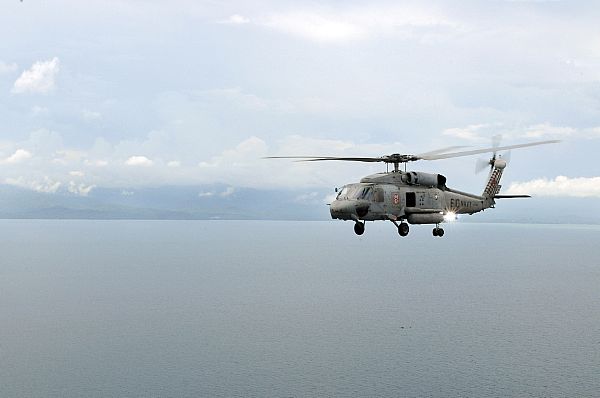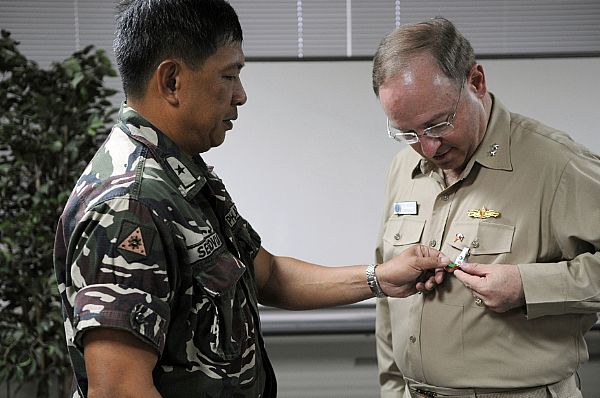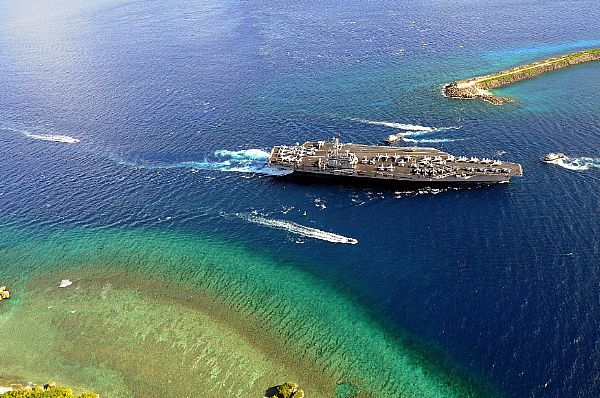USS Ronald Reagan Carrier Group Departs Philippines After Helping Typhoon Victims

080627-N-5961C-006 PACIFIC OCEAN (June 27, 2008) A helicopter assigned to the "Black Knights" of Helicopter Anti-Submarine Squadron (HS) 4 returns to the Nimitz-class aircraft carrier USS Ronald Reagan (CVN 76) after a day of delivering food to the Philippines. At the request of the government of the Republic of the Philippines, Ronald Reagan (CVN 76) is off the coast of Panay Island providing humanitarian assistance and disaster response in the wake of Typhoon Fengshen. Ronald Reagan and other U.S. Navy ships are operating in the 7th Fleet area of responsibility to promote peace, cooperation and stability.
U.S. Navy photo by Senior Chief Mass Communication Specialist Spike Call
|
Story Number: NNS080703-03
Release Date: 7/3/2008 3:36:00 PM
By Lt. Ron Flanders, USS Ronald Reagan
Public Affairs Carrier Group 7 Public Affairs
USS RONALD REAGAN, At Sea (NNS) -- The aircraft carrier USS Ronald Reagan (CVN 76) departed the Sulu Sea and the waters around the Philippine island of Panay, July 3, after assisting the Philippine government's humanitarian relief operation.
Prior to the group's departure, senior officers of the Armed Forces of the Philippines (AFP) thanked the more than 40 members of the strike group's humanitarian assistance support team in a special ceremony.
"We simply cannot put into words how grateful we are for your operational assistance," said Gen. Alexander Yano, AFP chief of staff.
"Together, we had a smooth coordination and maximization of our efforts to achieve our objectives of delivering help to typhoon-affected areas. This expeditious support testifies to the longstanding camaraderie between our armed forces."
At the request of the Philippine government, President George W. Bush ordered the Navy ships to render quick response to assist the AFP in relief efforts to Panay. Staging from the group's flagship, the Nimitz-class nuclear-powered aircraft carrier USS Ronald Reagan (CVN 76), the embarked aircraft of Carrier Air Wing (CVW) 14 provided a heavy lift capability that was vital to transporting food, potable water and medical supplies from Iloilo airport to sites all around the island.

080702-N-3659B-231 ILOILO, Philippines (July 2, 2008) Armed Forces of the Philippines (AFP) Brig. Gen. Jorge V. Segovia presents Rear Adm. James P. Wisecup, commander of the Ronald Reagan Carrier Strike Group, with the AFP Disaster Response and Recovery ribbon for the carrier group's role in the combined recovery efforts between the U.S. Navy and the AFP in the wake of Typhoon Fengshen.
U.S. Navy photo by Mass Communication Specialist 2nd Class Joseph M. Buliavac
|
Flying the humanitarian missions were C-2A Greyhound cargo aircraft from Fleet Logistics Squadron 30; HH-60H and SH-60F Seahawk helicopters from Helicopter Anti-Submarine Squadron 4, embarked aboard Ronald Reagan; SH-60B Seahawk helicopters from Helicopter Anti-Submarine Squadron Light (HSL) 49, embarked aboard the guided-missile cruiser USS Chancellorsville (CG 62), the guided-missile destroyer USS Howard (DDG 83), and the guided-missile frigate USS Thach (FFG 43); and HSL-37 embarked aboard the guided-missile destroyer USS Gridley (DDG 101).
Aircrews flew 332 sorties around Panay and delivered more than 519,000 pounds of much-needed supplies to typhoon victims. The four ships with Reagan positioned themselves around the island and served as fueling stations to keep the relief effort moving.
"This was a mission that was tremendously rewarding for our Sailors," said Rear Adm. Phil Wisecup. "The aircrews flew 20-35 missions per day, sunup to sundown. Our aircraft maintainers worked through the night. Every Sailor in the strike group had a hand in this.
"More importantly, we worked alongside our counterparts from the Armed Forces of the Philippines and brought real help to their people."

080706-N-5961C-002 PACIFIC OCEAN (July 6, 2008) The aircraft carrier USS Ronald Reagan (CVN 76) and Carrier Air Wing 14 (CVW 14) begin their transit into Agana Harbor for a port call on Guam after working off the coast of the Philippines in the wake of Typhoon Fengshen. The Ronald Reagan Carrier Strike Group is on a routine deployment in the 7th Fleet area of responsibility.
U.S. Navy photo by Senior Chief Mass Communication Specialist Spike Call
|
CVW-14 aircrews saw firsthand the devastation of the typhoon. Hundreds drowned in Panay, and thousands were left without clean water or food. The U.S. Navy and AFP personnel formed a quick-action team to get immediate aid to the most affected typhoon victims.
"Seeing the faces of the children when we landed was priceless," said Chief Aviation Warfare Systems Operator (NAC/AW) Andrew Smith, an HS-4 crew chief who flew for a week straight, delivering rice and water.
"When we got out to deliver the supplies, they were so happy; they just wanted to touch us. It is something I will always remember."
In addition to the airlifts, Ronald Reagan engineers ventured out into Iloilo and fixed generators that were completely submerged in water and mud, restoring electrical power to two local hospitals. Senior doctors from Reagan's health services department coordinated with AFP personnel and provincial government officials.
"The entire ship is feeling very good about what we did," said Capt. Kenneth Norton, Ronald Reagan's commanding officer. "We were just happy to help."
|